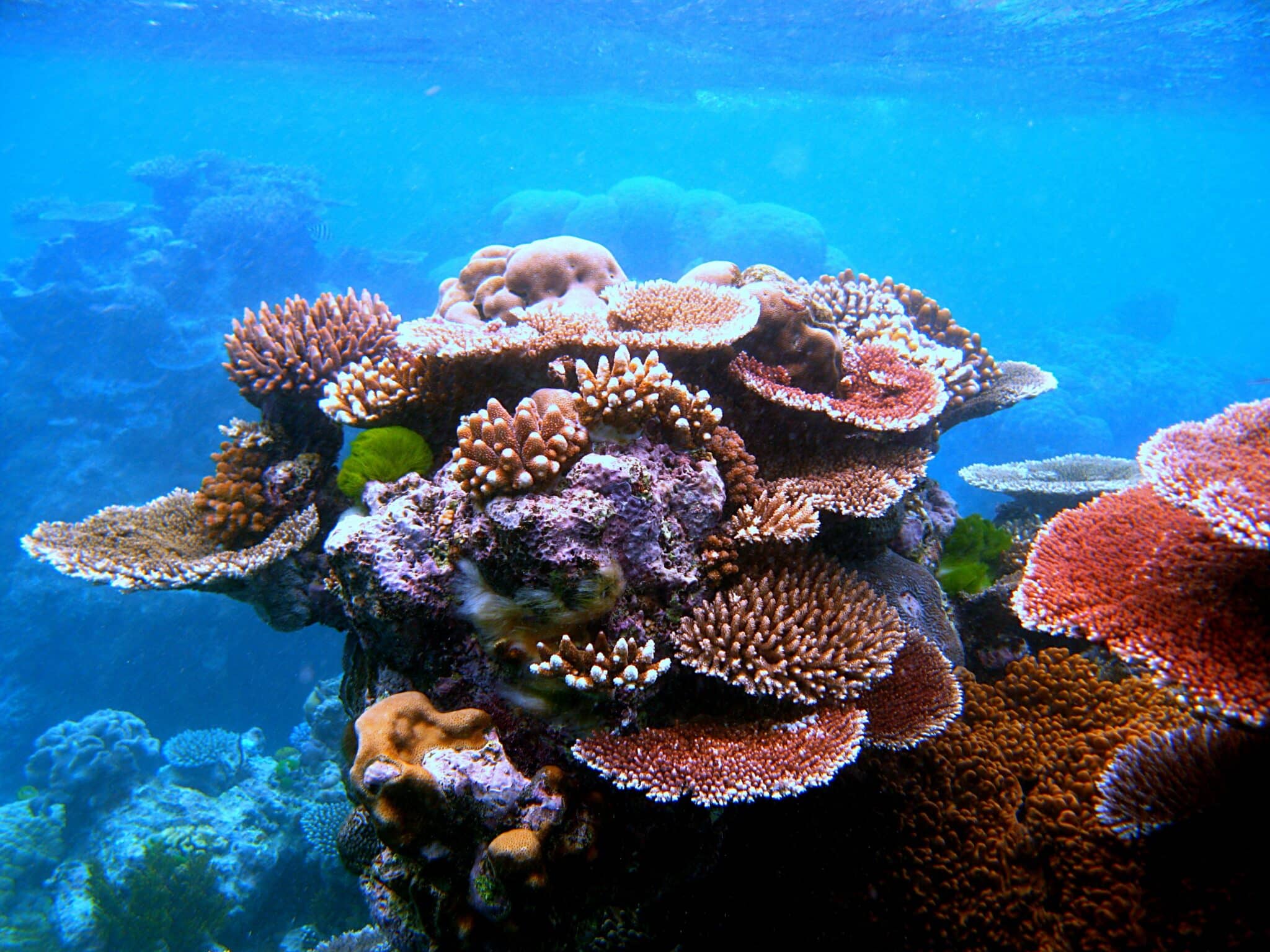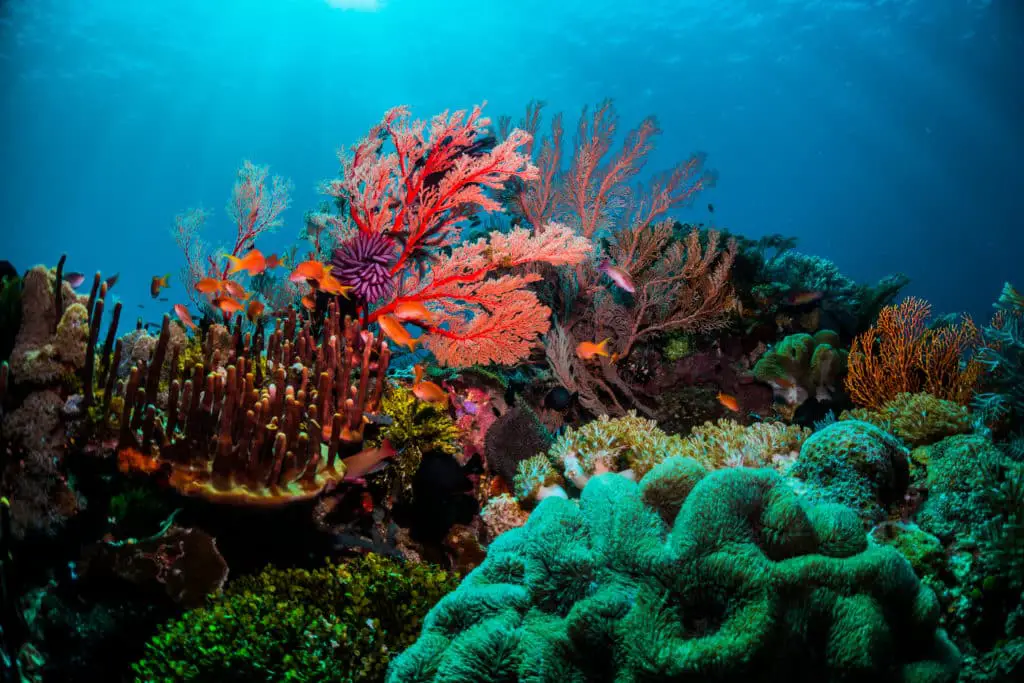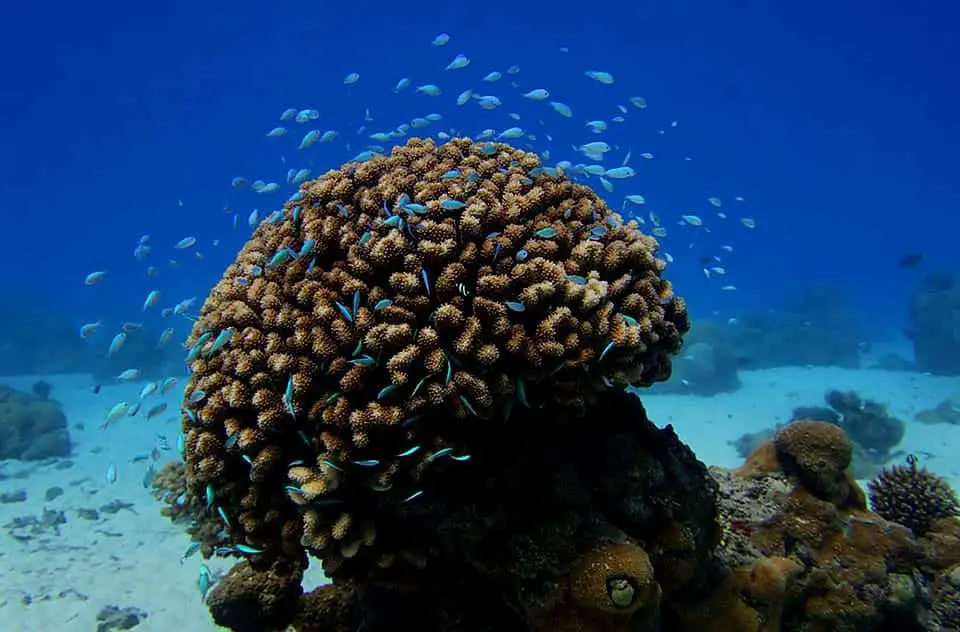How Long Does Coral Live

Coral outcrop on Flynn Reef
Introduction
How Long Does Coral Live: Coral reefs, the vibrant and intricate ecosystems beneath the ocean’s surface, have always held a profound fascination for scientists and nature enthusiasts alike. One of the most intriguing aspects of these underwater worlds is the longevity of the coral organisms that construct and sustain them.
Corals are not single organisms but rather colonies of tiny polyps that work together to build calcium carbonate skeletons, forming the exquisite structures we know as reefs. The lifespan of individual coral polyps is relatively short, often just a few years. However, the genius of coral lies in its ability to persist and thrive for centuries through a process of continual regeneration.
To understand the lifespan of coral, we must look beyond the individual polyps to the entire colony and the unique environmental factors that influence their longevity. Some coral species have been known to survive for hundreds of years, and perhaps even longer, making them some of the Earth’s oldest living animals.
This exploration will take us on a journey through the remarkable adaptations, threats, and ongoing research aimed at unraveling the mysteries of coral longevity. We will also delve into the vital role these ancient organisms play in marine ecosystems and the urgent need for their conservation in a world where coral reefs face unprecedented challenges.

How old is the oldest coral?
4,265 years old
A colony of black coral was determined to be 4,265 years old and are the oldest known marine organisms. Since corals can also reproduce asexually and continuously build colonies over time, some deep-sea coral reefs have been actively growing for 40,000 years!
The age of the oldest coral on Earth is a testament to the remarkable endurance of these marine organisms. Some corals have been found to be thousands of years old, making them among the planet’s oldest living creatures.
One of the most renowned examples is the deep-sea black coral (Leiopathes glaberrima), which has been dated to be over 4,000 years old. These ancient corals, discovered in the dark, frigid depths of the ocean, offer a glimpse into the extraordinary longevity of certain coral species. They grow incredibly slowly, adding just a few millimeters of skeleton per year, which contributes to their extreme age.
In shallower waters, massive and intricately branched corals like those found in the Great Barrier Reef or the Caribbean can also live for centuries. Some estimates suggest that certain species may live up to 500 years or more under the right conditions.
Understanding the age of the oldest corals is not only a matter of scientific curiosity but also vital for their conservation. These ancient organisms play a critical role in maintaining marine biodiversity and protecting coastlines from erosion. However, they face growing threats from climate change, pollution, and habitat destruction.
How fast is coral dying?
According to Forbes, scientists estimate about 70-90% of all coral reefs will disappear over the next 20 years.
The rate at which coral is dying is a matter of great concern in the scientific community and among environmentalists. Coral reefs, often referred to as the “rainforests of the sea,” are facing a crisis due to several interconnected factors, primarily driven by human activities.
The primary driver of coral mortality is climate change. Rising ocean temperatures result in coral bleaching events, where corals expel the symbiotic algae living within their tissues, leading to their death if the stress continues. The frequency and severity of these bleaching events have increased dramatically in recent decades, leaving many reefs devastated.
Ocean acidification, caused by the absorption of excess carbon dioxide by seawater, also harms coral by reducing their ability to build calcium carbonate skeletons.
Physical damage from coastal development, overfishing, and destructive fishing practices further exacerbate coral decline. Pollution from runoff and marine debris adds to the stress on coral reefs.
Efforts to mitigate coral decline include marine protected areas, coral restoration projects, reducing carbon emissions, and sustainable fishing practices. However, urgent and coordinated global action is needed to address these complex issues and give coral reefs a fighting chance at survival.
How long do corals live in a reef tank?
Coral Growth and Lifespan
While entire reefs may grow this old, each coral colony has a significantly smaller lifespan of hundreds of years. And individual coral polyps may only live for a couple of years.
The lifespan of corals in a reef tank, also known as a marine or saltwater aquarium, can vary widely depending on several factors, including the coral species, water quality, lighting, and care provided by the aquarium owner. Generally, corals in a well-maintained reef tank can live for many years, and some species can thrive for decades. Here are some key factors that influence the longevity of corals in a reef tank:
- Species: Different coral species have varying lifespans. Some soft corals may have a shorter lifespan, while hard or stony corals tend to live longer.
- Water Quality: Maintaining stable and optimal water parameters, including temperature, salinity, pH, and nutrient levels, is crucial for the health and longevity of corals.
- Lighting: Corals require specific lighting conditions to photosynthesize and grow. Providing the right intensity and spectrum of light is essential for their well-being.
- Water Flow: Adequate water circulation helps corals obtain nutrients and expel waste. Proper flow patterns prevent debris buildup and ensure their survival.
- Feeding: Some corals can capture and consume small prey, such as plankton. Supplemental feeding can enhance their longevity, especially in captive environments.
With proper care and attention to these factors, corals in a reef tank can live for many years, offering reef enthusiasts the opportunity to create and enjoy thriving miniature marine ecosystems in their homes.
How long can coral grow?
With growth rates of 0.3 to 2 centimeters per year for massive corals, and up to 10 centimeters per year for branching corals, it can take up to 10,000 years for a coral reef to form from a group of larvae. Depending on their size, barrier reefs and atolls can take from 100,000 to 30,000,000 years to fully form.
The growth potential of coral colonies is a remarkable aspect of these marine organisms. Under optimal conditions, corals can continue to grow throughout their lifespan, which can span decades to centuries. Several factors influence the rate and duration of coral growth:
- Species: Different coral species exhibit varying growth rates and maximum sizes. Some of the slowest-growing species may add just a few millimeters of skeletal growth per year, while others can grow several centimeters annually.
- Environmental Conditions: Corals thrive in warm, clear waters with ample sunlight. Adequate water temperatures, light for photosynthesis, and suitable nutrient levels are essential for sustained growth.
- Water Quality: Stable water quality, including appropriate levels of pH, salinity, and nutrient concentrations, is crucial for coral growth. Poor water quality can stress corals and inhibit their growth.
- Competition and Space: Coral growth is influenced by the availability of space on the substrate. Corals compete for space and resources with other corals, algae, and encrusting organisms, which can affect their growth rate.
In the right conditions, some coral species have been documented to grow for centuries, with massive colonies forming over time. Understanding coral growth is not only crucial for coral reef ecology but also for conservation efforts aimed at protecting these vital ecosystems in the face of climate change and human impact.
Is coral a plant or animal?
Animals
Corals are in fact animals. The branch or mound that we often call “a coral” is actually made up of thousands of tiny animals called polyps. A coral polyp is an invertebrate that can be no bigger than a pinhead to up to a foot in diameter.
Coral is not a plant; it is an animal. Specifically, corals belong to the phylum Cnidaria, which also includes jellyfish and sea anemones. While they may resemble colorful, stationary plants, corals are actually colonies of tiny, individual animals called polyps.
Each coral polyp has a tubular body with a mouth surrounded by tentacles armed with stinging cells called cnidocytes. These tentacles are used for capturing small planktonic organisms and defending against predators. Coral polyps live in a symbiotic relationship with photosynthetic algae called zooxanthellae, which reside within their tissues. This partnership allows corals to obtain essential nutrients and oxygen from the algae’s photosynthesis.
Corals are unique in that they secrete a calcium carbonate skeleton, which forms the hard, rock-like structures we associate with coral reefs. Over time, as individual polyps reproduce asexually and build upon the existing skeleton, they create large, complex colonies that make up coral reefs.
The vibrant colors of coral colonies come from the pigments in the zooxanthellae, and the health of the coral relies on the successful functioning of this symbiotic relationship. Corals are vital to marine ecosystems, providing habitat for a diverse array of marine life, and they are often referred to as “rainforests of the sea.”
Do all coral species have similar lifespans?
The lifespan of coral species can vary widely, depending on a range of factors, including their growth rate, environmental conditions, and susceptibility to stressors.
- Growth Rate: Coral species exhibit different growth rates. Some corals, like branching and staghorn corals, tend to grow faster and can reach reproductive maturity in just a few years. Other species, such as massive or boulder corals, grow much more slowly, adding only a few millimeters of skeletal growth per year.
- Environmental Conditions: The conditions in which corals live play a significant role in their longevity. Corals in nutrient-rich, stable, and well-lit environments tend to grow faster and live longer. Conversely, those in areas with poor water quality, high temperatures, or frequent disturbances may have shorter lifespans.
- Sensitivity to Stressors: Some coral species are more resilient and adaptable than others. Species with high stress tolerance may survive and recover from bleaching events, diseases, or physical damage more effectively, potentially leading to longer lifespans.
- Reproductive Strategies: Coral species employ various reproductive strategies, which can impact their lifespan. Some produce a vast number of offspring frequently, while others invest more energy into fewer, larger offspring less frequently.
- Predation and Competition: The presence of coral-eating predators or competition with other species can also influence coral lifespans, as these factors can stress or damage corals.
Coral species do not have uniform lifespans. They exhibit a wide range of growth rates and survival strategies, resulting in varied lifespans. Understanding these differences is crucial for conservation efforts and assessing the health of coral reefs, which are under increasing threats from climate change and human activities.
What happens after coral dies?
Once coral reefs die, they are gone for the foreseeable future, and due to their incredible importance as hotspots of marine biodiversity, the loss extends far beyond the reach of the ecosystem itself. Tropical fish populations decrease – nearly half the fish that the world depends on come from coral reefs.
After a coral colony dies, a series of complex ecological processes and transformations take place within the marine ecosystem. Initially, the dead coral structure, often referred to as coral rubble, provides a substrate for various organisms to colonize. Algae, sponges, and other encrusting organisms may quickly cover the coral skeleton. This phase can alter the appearance and functionality of the reef, as the vibrant, three-dimensional structure of living coral is gradually replaced by a more flattened, encrusted surface.
Over time, the dead coral skeleton can begin to break down due to physical and chemical processes. Wave action, erosion, and bioerosion by creatures like parrotfish and boring sponges contribute to the breakdown of the calcium carbonate structure. As the coral skeleton erodes, it can create sand and fine sediments that become part of the surrounding seafloor.
While these processes transform the coral skeleton, they also impact the broader ecosystem. The loss of live corals can have devastating consequences for the diverse marine life that relies on coral reefs for food and shelter. Consequently, when corals die, it underscores the urgency of protecting these vital ecosystems to ensure the survival of countless species and the preservation of the myriad ecological services that coral reefs provide, from fisheries to shoreline protection.
Can coral colonies regenerate or repair themselves?
Coral colonies possess a remarkable ability to regenerate and repair themselves, albeit within certain limitations. Corals are colonial organisms comprised of tiny individual polyps that collectively build intricate calcium carbonate skeletons, forming the stunning coral reefs we know. When subjected to various stressors such as storms, coral bleaching, or physical damage, these colonies can initiate processes aimed at recovery.
One mechanism for regeneration is polyp budding, where new polyps sprout from the existing ones, gradually rebuilding damaged portions of the colony. Additionally, corals can heal minor injuries by secreting calcium carbonate to patch exposed areas.
However, these regenerative abilities have their limits, especially when facing severe and prolonged stressors like elevated sea temperatures and ocean acidification, primarily caused by climate change. In such cases, corals may struggle to recover and can ultimately succumb to irreversible damage, leading to coral reef degradation.
Efforts to protect and restore coral reefs include conservation measures to mitigate stressors and promote healthier environments. Researchers are also exploring innovative techniques like coral propagation and assisted evolution to enhance the resilience of these vital marine ecosystems.

Conclusion
In our quest to understand the lifespan of coral, we have unearthed a world of marvels and challenges that these ancient organisms face. Coral reefs, with their intricate beauty, are not just static formations; they are dynamic ecosystems sustained by the remarkable persistence of coral colonies.
We have discovered that individual coral polyps may have relatively short lives, but the collective resilience of the colony is awe-inspiring. Some coral species, defying the passage of time, can endure for centuries or even millennia. This longevity, however, is increasingly threatened by climate change, ocean acidification, pollution, and overfishing.
The significance of coral reefs extends far beyond their aesthetic appeal. They serve as biodiversity hotspots, nurseries for countless marine species, and natural barriers against coastal erosion and storms. Therefore, the conservation of coral reefs is not merely an ecological concern; it is a global imperative.
Scientific research, conservation efforts, and international collaboration are essential to ensure the survival of coral reefs and the myriad life forms they support. Our commitment to preserving these underwater wonders will determine whether coral continues to thrive for generations to come, or whether its ancient legacy becomes a poignant memory of what once was.



